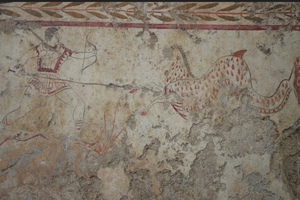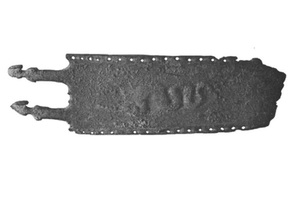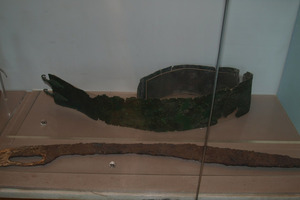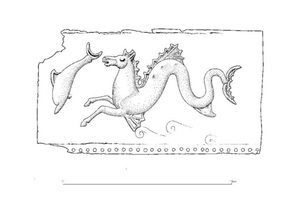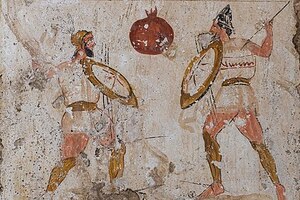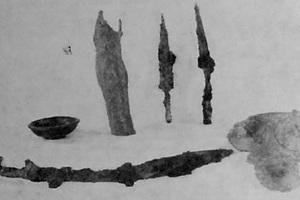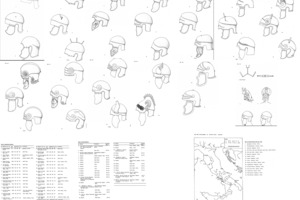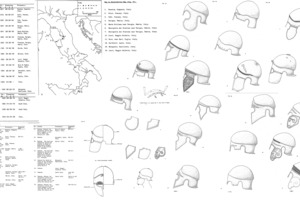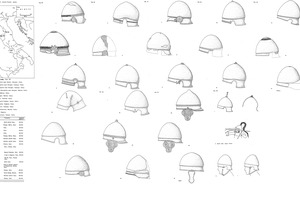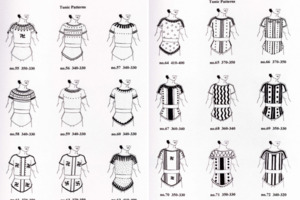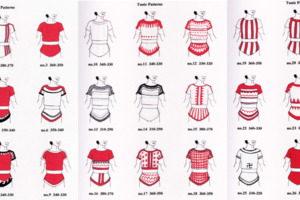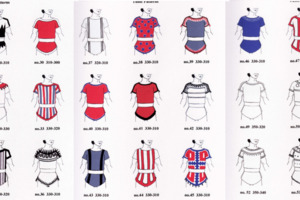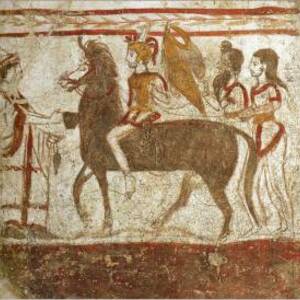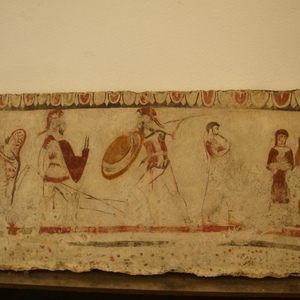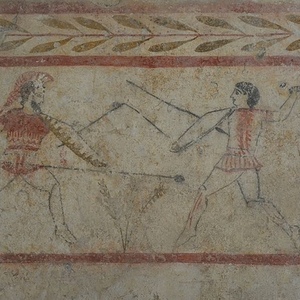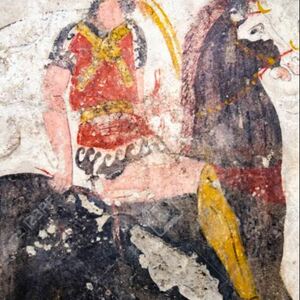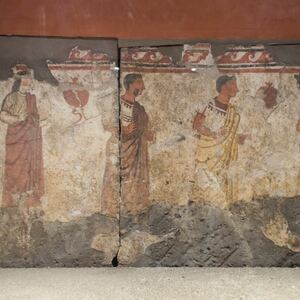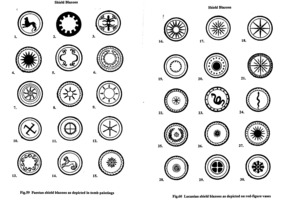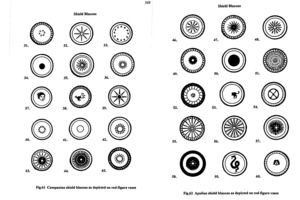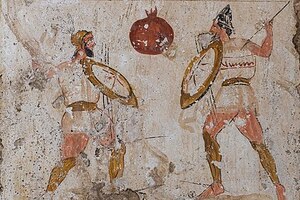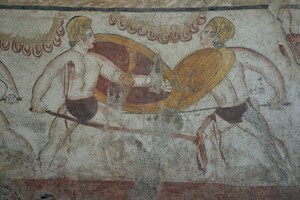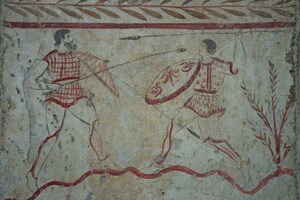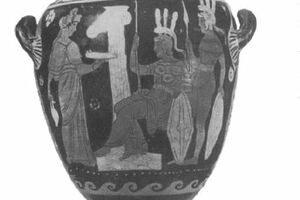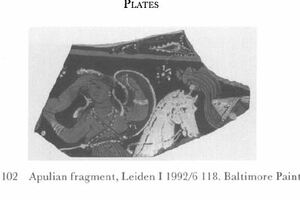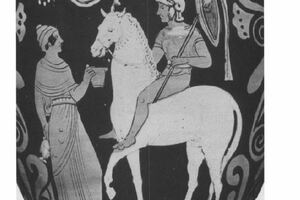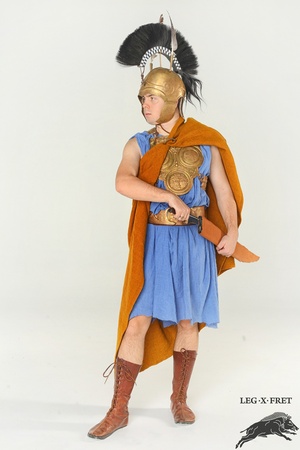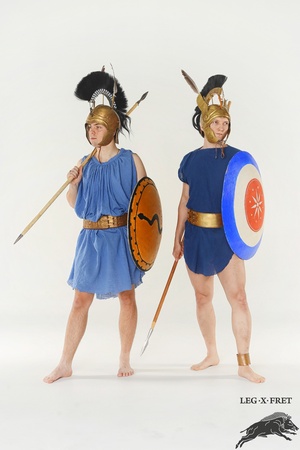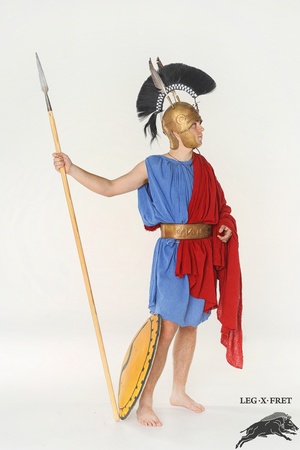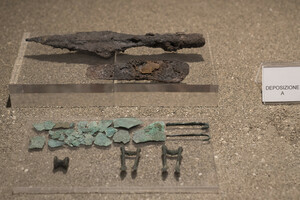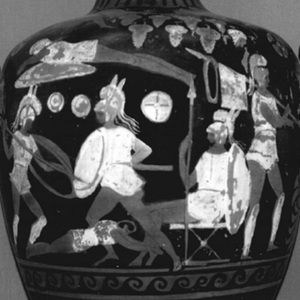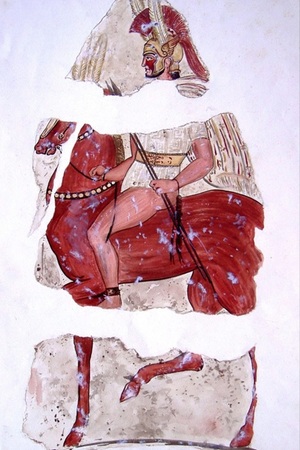Samnite Warrior
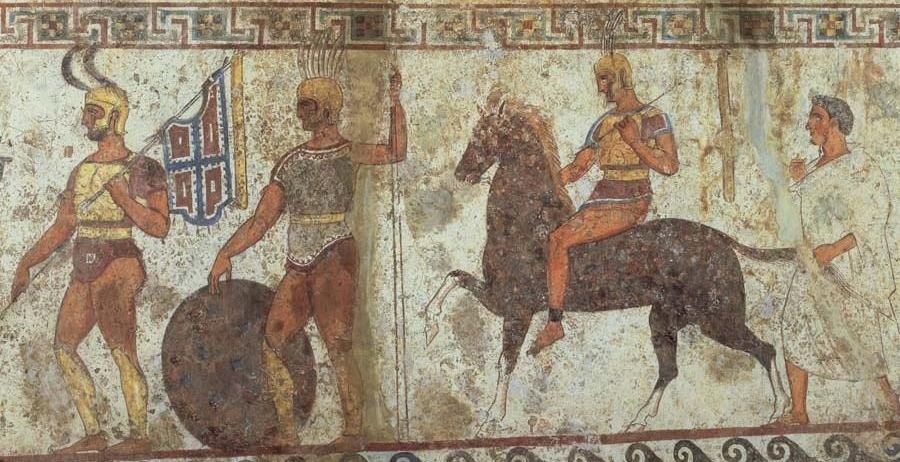 Fresco from the Fortress of Nola, Campania. 330-310 BC.
Fresco from the Fortress of Nola, Campania. 330-310 BC.
Samnite Warrior
The Samnites were an ancient Italic people living in southern Italy. Their significant historical influence spanned from the 6th to the 3rd century BC. Due to their relatively short existence as an independent civilization, they did not fully develop a distinct culture. Their proximity to the Greek colonies in Magna Graecia resulted in significant cultural influences, creating an interesting blend of Italic and Greek material culture.
The peak of Samnite culture coincided with the weakening of the external policies of ancient Etruria, particularly in the southern part of the Apennine Peninsula. This likely allowed the Samnites to assert themselves, including in material culture. Their primary cultural distinctions from other Italic peoples are reflected mainly in their clothing, patterns, and weaponry. Many typical Samnite artifacts have been found not only in southern Italy but also in the Alps and even in North Africa, suggesting that Samnite warriors often served as mercenaries.
Military Affairs
Like most of the peoples of Italy at the beginning of the Iron Age, the Samnites adopted their weapons and fighting style from a neighboring more advanced civilization located on the other side of the Tyrrhenian Sea- the Greeks. Historians suggest that cultural exchange began at least in the 7th century BC. e. Samnites began to use round shields (hoplons), one - handed spears, arm and leg armor, Greek-style helmets, and body armor, similar to the Greek phalanx of the transitional archaic-classical period. General trends in military affairs in Italy were noticeably lagging behind Greece, so in the V-IV centuries BC you can see tombs with warriors, including full muscle armor, greaves, bracelets, forearm armor and heavy helmets. A similar set of weapons for this period in Greece itself is already considered long out of use.
Like most early Iron Age Italic peoples, the Samnites adopted their weapons and combat techniques from the more advanced neighboring civilization across the Tyrrhenian Sea – the Greeks. Historians suggest that cultural exchange began as early as the 7th century BC. The Samnites began using round shields (hoplons), one-handed spears, arm and leg armor, Greek-style helmets, and body armor similar to the Greek phalanx of the transitional Archaic-Classical period. The overall trends in Italian military affairs lagged behind Greece, evident in the 5th-4th centuries BC when tombs containing warriors with complete muscle armor, greaves, armguards, and heavy helmets were common. Such equipment was already considered obsolete in Greece by that time.
Spears
As Samnite military affairs developed, lightly armed warriors became more prevalent, and by the 4th century BC, Samnite armaments were simpler than those of Greek hoplites. Most depictions show Samnites as firm adherents to spears as their primary weapon. These can be roughly classified into four types:
- Hunting Spears – Long, with thick shafts and long points.
- Javelins – Thin shafts, small points, 140 to 180 cm long.
- Duel Spears – Medium shafts, large points (20 cm or more), 170-200 cm long.
- War Spears – Universal for close combat and throwing, 160-200 cm long.
Some depictions show spears with loops on the shafts, possibly for carrying or enhancing the throwing distance, similar to those used by some contemporary South American tribes still hunting in forests.
It's noteworthy that most images of Samnites depict one-on-one duels rather than mass battles. This may indicate fundamental differences from Greek combat tactics, although it could also be a convention of visual art.
Bows Despite the dominance of spears, alternative weapons were also used. For ranged combat, the Samnites employed archers alongside light skirmishers with javelins. The bows, judging by depictions, were composite recurve bows, similar to those of many other ancient peoples.
Swords
Swords were rare among the Samnites, with only a few archaeological finds and images from southern Italy of that period. Found swords can be divided into two types: kopis and double-edged xiphos, both borrowed primarily from the Greeks. Among the Samnites, these blades served a secondary role, used only when spears became impractical (due to breakage or close combat).
A notable find in Paestum includes a large kopis paired with typical Samnite equipment, likely belonging to a mounted warrior due to its atypical blade length (around 70 cm), which was unusual for infantry swords of the period. The overall geometry of Samnite swords did not differ from those of neighboring peoples.
There is a similarity between the hilt of a kopis from Capua, shaped like a horse's head, and Iberian kopis, where this feature is typical.
Belts
Another distinctive element of Samnite equipment is their belts, made from long brass plates fastened to leather. They were secured with cast hooks inserted into holes in the brass base. These belts were often decorated with embossing, frequently featuring mythological themes (sea monsters, Pegasi, etc.).
Body Armor
Despite depictions of muscle cuirasses and linothoraxes in southern Italy from that period, it cannot be confirmed that they were widespread. The primary torso protection was cardiophylaxes or none at all. Cardiophylaxes, such as three-disk armors, were the most distinctive Samnite protective equipment. Some imitated the male torso, a stylization of Greek muscle cuirasses but inferior in weight and protection. This discrepancy might be due to the region's overall poverty or the emphasis on warrior mobility in Samnite military tactics.
Greaves A significant number of vase paintings and tomb frescoes depict Samnites wearing greaves, both single (left) and in pairs. These greaves resemble classical Greek anatomical greaves. Archaeological samples include rings on the back, used for tying with a cord. Sometimes, instead of greaves, an ankle bracelet is used as decoration.
Footwear
There are no finds of Samnite footwear. According to visual sources, they used Roman caligae and Greek kampagia, sandals, and various types of boots. Some images show Samnites barefoot.
The helmet Helmets Bronze helmets were widely used from the 6th century BC. They can be divided into several types: Pilos, pot-like (Negau), Etruscan-Thracian, Chalcidian, Apulo-Corinthian, and Samno-Attic, often considered a subgroup of Chalcidian helmets.
The popularity of various helmet types peaked at different times. Apulo-Corinthian helmets - 6th-5th centuries BC, Etruscan-Thracian - 4th-3rd centuries BC, Negau - 5th century BC, Italic Pilos - 4th century BC, Italic-Chalcidian helmets - 5th-4th centuries BC, Samno-Attic helmets - 4th-3rd centuries BC.
Each type of helmet exhibited significant variety in construction and decoration, indicating a lack of standardization or firmly established military traditions. Detailed nuances of Samnite helmets can be found in "The Bronze Italian Helmet: The Development of the Cassis from the Last Quarter of the Sixth Century B.C. to the Third Quarter of the First Century A.D." by John Miles Paddock. The most common type was the pot-like (Negau) helmet, likely due to its simple manufacturing process.
Negau, Etruscan-Thracian, and pot-like helmets were probably products of local smithing evolution rather than direct Greek borrowings. Chalcidian helmets and Pilos were direct analogs of Greek helmets. Apulo-Corinthian and Samno-Attic helmets were local offshoots of Greek Corinthian and Chalcidian helmets. Apulo-Corinthian helmets were the most distinctively Italic, functionally different from their predecessors, with facial openings moving to the forehead and becoming decorative, possibly worn with chin straps and richly adorned with patterns and embossing. The type of cheekpieces on these helmets remains ambiguous, with no complete archaeological finds including both helmet and cheekpieces.
Samno-Attic helmets became characteristic of Italy from the 4th century onwards, widely used. They featured ear cutouts, lacked a nasal guard, and often had crest mounts. The crests typically included a longitudinal comb of horsehair and feathers mounted in various combinations. The comb was held by a forked holder above the helmet. Additionally, wings on the sides of the helmet could be used for decoration, a feature later characteristic of a gladiator type in ancient Rome representing the defeated Samnite people (Samnite gladiator).
Samno-Attic helmets were used not only by Samnites but also by Romans.
Tunics
Diversity
More than half of the surviving images of Samnite warriors show no body armor, making the tunic one of the defining attributes of their appearance. A unique feature of the Samnites was their clothing decoration. Unlike Romans and Greeks, they often decorated their clothing with patterns. No textile finds from the Samnites have survived, but it is likely that such patterns were achieved through tunic dyeing. According to Dionysius and Livy, linen was used alongside wool.
In most depictions, Samnites wore very short and narrow tunics, similar in length to modern shirts, barely covering their private parts. In contrast, Roman tunics were voluminous and sack-like, often reaching the knees. The lower edge of the Samnite tunic was often intricately shaped, shorter near the hips, making Samnites easily recognizable.
In some images, Samnite tunics reached mid-thigh and included a few depictions of Samnites in Ionian-style chitons, typical of Greeks. However, such images are much rarer.
Patterns
A significant portion of the tunics in the images are monochromatic and do not feature any patterns, but there are still many patterned ones. Archaeologists divide the tunics into four types based on their regions of use: Lucanian, Campanian, Apulian, and tunics from Nola (a small region near Capua). Apulian tunics arguably have the most complex patterns, possibly due to the region's better material prosperity. The primary colors were red, white, blue, black, and mustard.
Samnite Shields
In most visual sources, Samnite warriors are depicted with a round shield, most likely a hoplon or its variations. It is believed that hoplons began to be used in Italy starting from the 7th century BC during Greek colonization and the introduction of the phalanx in warfare. Hoplons could vary in size from 70 cm to 100 cm (judging by the size ratios with the human body in images), just like the Greeks. The shield could be fully covered with bronze or just along the edge. They could be monochromatic (typically white) or feature various patterns. Among the Samnites, abstract (geometric) patterns predominated over zoomorphic ones in visual sources.
Many images on vases and some tombstones show other variations of round shields. These could be smaller versions of the hoplon, similar to the pelta used by Macedonian phalangites of the same period. These might also be artistic distortions of the regular hoplon’s size. Countering this theory is the fact that Samnite warriors are often depicted riding horses with a spear on their shoulder, with a shield, belt, and clothing elements attached to its tip. Such a construction can only be practical with a lightweight shield, which is almost impossible with a classic hoplon.
Another variant of the round shield is the so-called "parasols," named for their resemblance to umbrellas. Shields of this structure have not survived to our time (not to mention that only two classic hoplons have survived, despite their widespread use). It might be a unique construction used only by the Samnites. Another version suggests it could be a way to depict the hoplon, but this hypothesis is less convincing since we can observe both the parasol and a regular hoplon in the same image.
Rarely, irregularly shaped peltae resembling those of Greek peltasts and Thracians are found. It is likely that among the Samnites, they were primarily used by skirmishers. Occasionally, shields similar in construction to Celtic ones with a wooden spine are also found, usually oval or diamond-shaped. Interestingly, Livy describes Samnite shields, which he calls "thureos," indicating their elongated shape.
Livy wrote about the use of "scutum" by the Samnites, which the Romans directly inherited from them. This information should be taken with skepticism since many of Livy's descriptions conflict with archaeological data and his contemporaries. This also applies to his descriptions of Samnite weaponry. Among archaeological finds, there is no depiction matching the description of a trapezoidal, partially concave shield. The closest analogy is the shield of a Samnite gladiator, dating to the 1st century BC.
Samnite warrior equipment
The equipment of a Samnite warrior from the 5th to 3rd centuries BC could consist of the following elements:
Textile/Leather Items:
- Shoes (Caligae or Cambagae)
Metal Protective Equipment:
- Ocrea or a bracelet on the leg
Weapon:
- Hoplon or its smaller variations (for example, pelta)
Additional Elements:
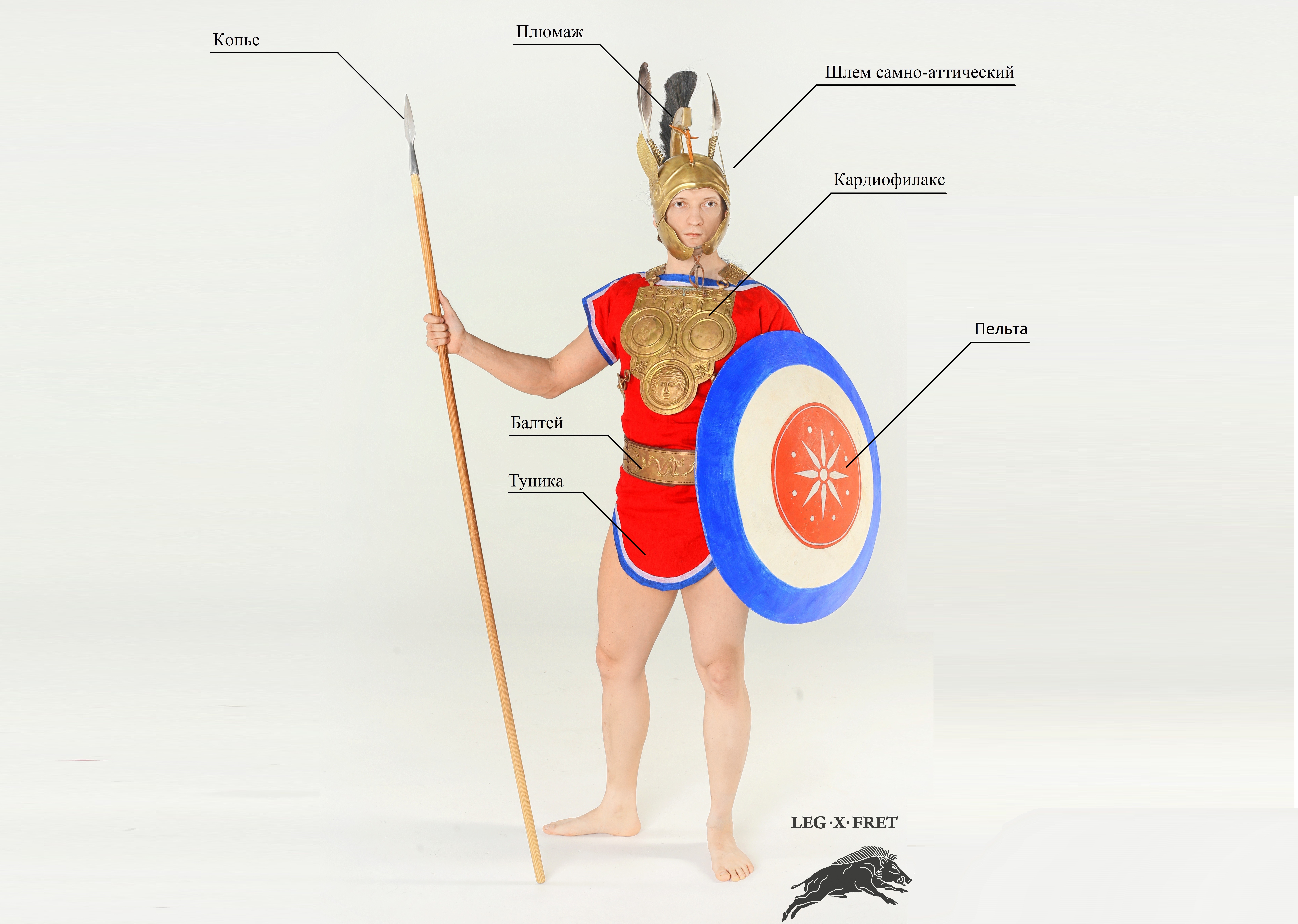 Samnite Warrior. Reconstruction.
Samnite Warrior. Reconstruction.
Reconstruction
Throughout their existence, the Samnites exhibited a mix of classical Italic and Greek influences. According to visual sources, the degree of influence varied—sometimes a Samnite warrior could look like a copy of a Greek hoplite. When recreating the image, it is recommended to use the most distinctive elements that emphasize belonging to the Samnites: a tunic with exposed thighs, a wide belt with a brass insert, and a cardiophylax. For a basic event set, it is recommended to assemble a spear, shield, tunic, footwear, and belt.
Related topics
Samnite Wars, Tunic, Hoplite, Chlamys, Samnite Women
Literature
2. The sarnnite warriors appearance. 1995
4. Collection of vase paintings with Samnite themes
5. Peter Connolly: "Greece and Rome"

 Gallery
Gallery






